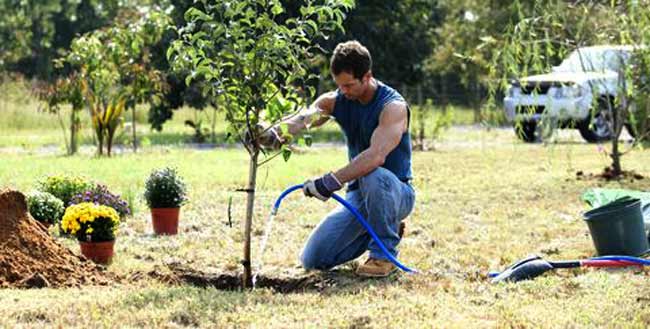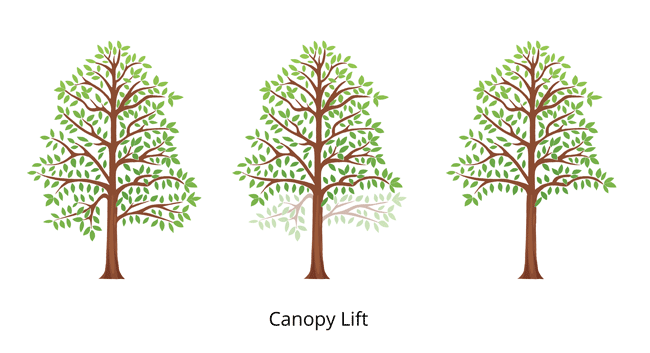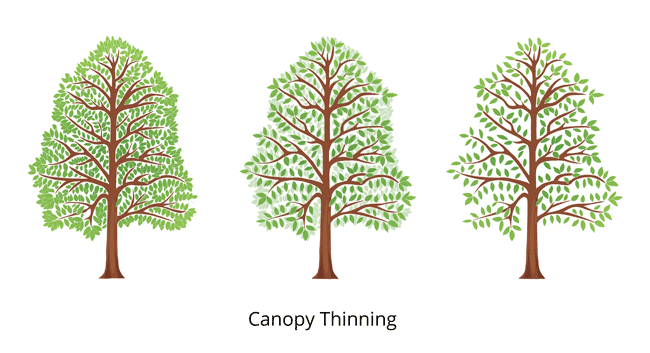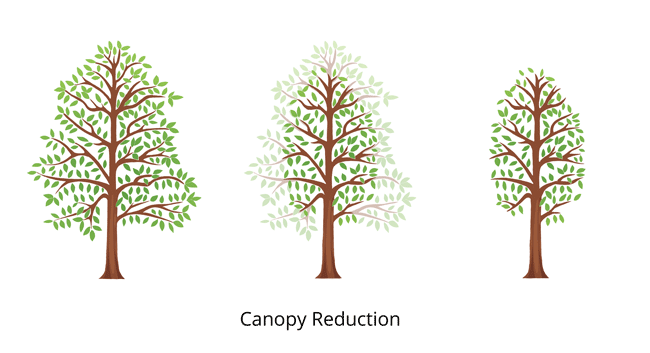A tree maintenance plan provides guidelines and strategies to ensure the health and survival of your trees.
It can include a schedule to assess the tree; structure and safety and present an outline for trimming and pruning.
Like humans, trees need a lot more care1 when they are younger, especially when newly planted. They will need regular watering and pruning to ensure growth and structural integrity while they grow.

What we cover
ToggleSo what does a basic plan look like?
Example of a basic tree maintenance plan
Identify tree
Tree 1: White Oak tree
Age: 9 months
Height: 3 feet
Location: Front yard – full sun
Purpose of plan
The purpose of this tree management plan is to form practices that protect and maintain the trees on X property. Some specific objectives of this plan are:
i) First and foremost the safety of the community living with the trees
ii) Second the health of the tree
iii) Third the aesthetic appeal of the tree
Watering plan:
| Tree age | Water (in gallons) | Frequency p/w |
|---|---|---|
| 0 – 6 months | 3 | 7 |
| 6 – 12 months | 8 | 4 |
| 1 – 2 years | 10 | 4 |
| 2 – 5 years | 20 | 2 |
| 5 – 8 years | 40 | 1 |
| > 8 years | The tree should now be deep-rooted enough to draw from the water table below the ground. |
Pruning Schedule:
Depending on the age of the tree, the pruning3 schedule will differ. The below time frames are not hard and fast rules as all trees grow at different rates and require formative pruning more regularly than others. Below is a good guide if the trees do not need pruning beforehand due to encroaching on buildings or walkways.
Resource: Tree trimming cost guide
a) Objectives – Clear objectives need to be established before you prune. These objectives might change from one prune to another and should be clearly stated before you start.
See below the schedule for common pruning objectives.
| Tree age | Frequency | Common objectives |
|---|---|---|
| 0 - 5 years | annually | Structural, train to a single leader |
| 5 – 15 years | 2 – 5 years | Structural, Clearance, thinning |
| 15 – 25 years | 5 years | Thin, deadwood, clearance |
| 25 years + | 5-8 years | Dead, dying, diseased & defective branches. |
Common objectives of pruning
1. Raising the canopy “canopy lift” – This is the pruning of the lower branches of a tree to allow more light into a building or to the grass below. It might also be to allow a foot or more for car traffic to pass more easily.

2. Thinning the tree – Canopy thinning is the practice of removing some inner branches to let light and airflow to the center of the tree. This reduces the instances of fungal issues moving forward.

3. Reduction – This refers to the removal of 3rd and 4th-order branches to reduce the overall size of the tree.

4. Obstacle clearance – It is common to remove branches that are growing into signs, buildings, or power lines.
5. Deadwood removal – This is the practice of routinely removing dead branches that accumulate on mature trees. Some trees more commonly get branches that die and shed. It is better for the tree and pedestrians that these branches are removed before they fall.
b) Ground cover: Mulched area up to 20 inches outside the drip line of the tree canopy.
c) Fertilize: This should be done once every 3 – 4 years, regardless of age. You will need to be particularly careful with juvenile trees that can die from being given too much chemical fertilizer. Your best bet is compost or any type of natural fertilizer.




Forming a management plan
Below are some things to consider when forming your tree management plan. The above is just an example and you can easily adapt it to all different trees like fruit trees, palm trees, and other slower-growing trees.
Assess your trees
Develop a strategy to evaluate your trees which can include learning about their different species, and how to care for their overall health.
a) How much water do they like?
b) How often do they like to be watered?
c) Are there any inherent structural problems with your particular species of tree?
d) Do they suffer from common fungal or pest problems?
At this point, it may also be a good idea to map out the trees included in your plan.
Plot out where they are located and what the different species are. This way it’ll be clear for any future maintenance.
Learn About Invasive Tree Pests
Trees are hardy. They can hold up to attack from pests for some time, but after continuous assaults, they can even succumb to these intrusive creatures.
Some tree populations have been reduced substantially due to disease or pests. The American Chestnut tree is one of the most well-known. An estimated three billion chestnut trees were killed due to a blight which was caused by an Asian bark fungus.
Learning about these diseases and pests is imperative to the survival of certain tree species. Knowing where to look for problems and what to do if they’re found is essential to a healthy tree life.
Caring for Trees – A Basic Plan
There should be a plan in place regarding caring for the tree. This means from the time it’s planted to the care needed every year. It will include types of soil, fertilizer, and pruning. More information on how to care for a tree is included further below.
Planting New Trees and Maintaining Existing Ones
Steps to Maintain a Tree
Just as important as developing a basic tree plan is learning how to properly plan and care for a tree. The steps below should be followed for optimal survival.
As mentioned above, if tree inventory has been mapped out then it’ll be easy to see where new trees are needed. While it’s important to bring in new trees, caring for the existing ones is equally as important to ensure long-term survival.
Choosing the Right tree
Know where the tree is being planted. That’s the first step necessary in picking the perfect one. Research how tall it will get – don’t plant something that will interfere with utility lines. Check out guidelines for sunlight and soil types. Learn about how to care for the species, not only that but it’s important to know how it grows in the designated area – can it survive winter?
Properly Plant
There is a way to properly plant a tree. This includes digging a hole that’s 2-3 times wider than the roots. Add some water and place the tree into the hole moving it so it faces the direction desired. Fill in with remaining dirt.
The tree should be watered immediately after planting and every day thereafter to ensure proper growth. After a week or two, the frequency of watering can be reduced.
Fertilizer
Fertilizer is of little benefit to a newly planted tree. It can damage them. The high nitrogen in the fertilizer can damage roots and leaves. Better to wait until the tree is older.
Fertilizer can be used on young trees. Check the instructions first, but it’s usually recommended to fertilize once or twice a year on these growing trees.
Fertilizing in the spring can help promote new growth through the fall. It’s also helpful to fertilize in the fall and add nutrients needed for winter.
If some dead branches and leaves aren’t a lush green color, that may indicate that it’s time to get out the fertilizer. This simple task will keep your tree healthy and promote new growth.
Mulching
Mulching trees2 can be done to protect roots from the elements as well as retain heat in the ground and enzyme activity. Although not required when planting a tree, it does have some benefits but is mostly decorative.
You can use a woodchipping service near you to supply and deliver mulch to you.
As the mulch decomposes it can provide additional nutrients to the growing tree.
Proper mulching requires it to be spread evenly a few inches deep but should not come into contact with the tree trunk. Contact with the tree trunk can cause excessive moisture which can lead to an increase of insects and pests and cause disease or decay.
Pruning
There are several different reasons to prune a tree. They can range from enhancing their appearance to removing diseased portions.
Winter pruning is essential to enhance new growth in the spring. Pruning for appearance is usually best at this time as well since the branches can be seen clearly without all the leaves. Pruning after the coldest part of winter is the most beneficial.
It is not recommended to prune a tree in the fall. It can actually weaken the tree and that’s the last thing needed heading into winter.
Developing a tree management plan and learning how to maintain a tree (tree maintenance plan) is essential to its survival and long-lasting health.
- Arbor Day Foundation, (2019) Tree Care Tips & Techniques. <https://www.arborday.org/tree-care-maintenance> Accessed: 23-02-2024
- David R. Jackson, (2018) Mulching Landscape Trees. <https://extension.psu.edu/mulching-landscape-trees> Accessed: 23-02-2024
- ISA, (2019) Pruning Your Trees. <https://www.treesaregood.org/treeowner/pruningyourtrees> Accessed: 23-02-2024





